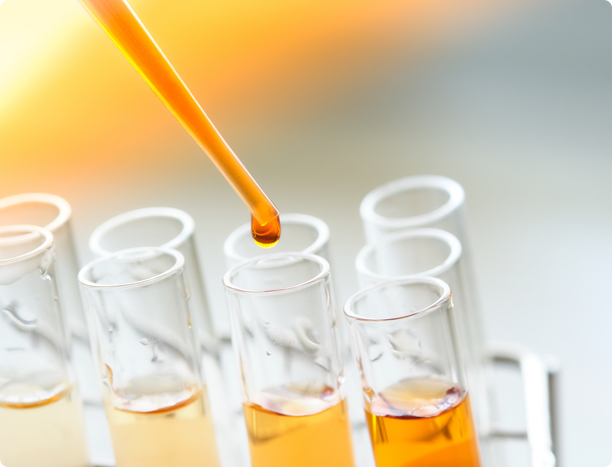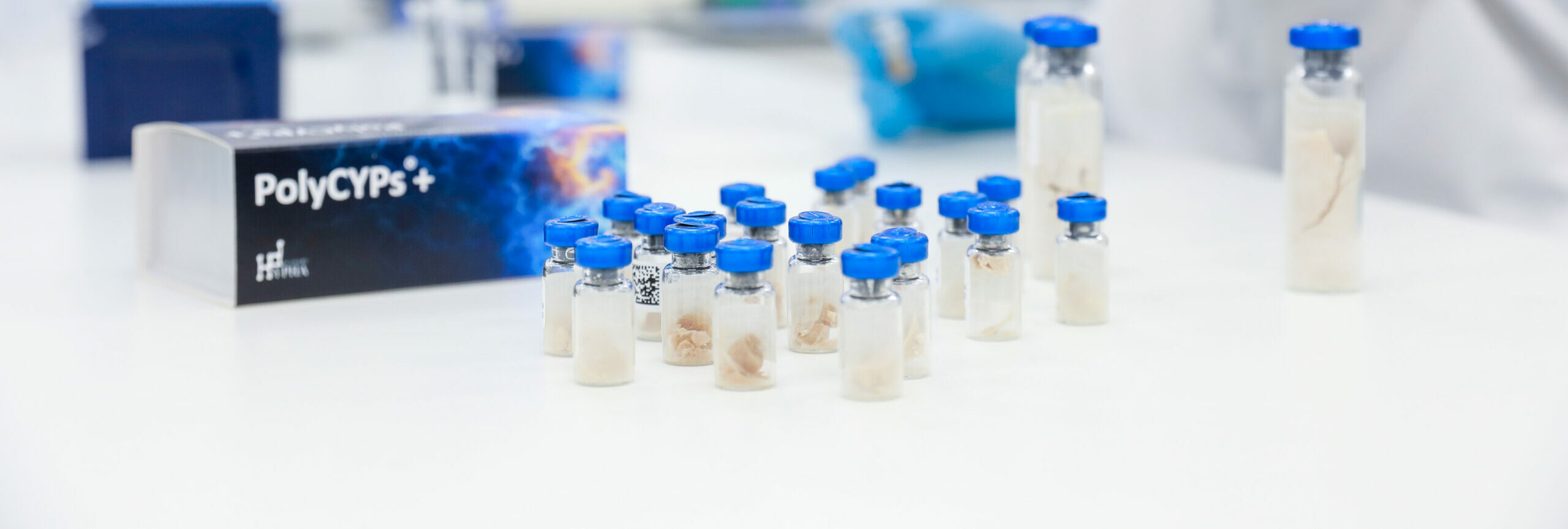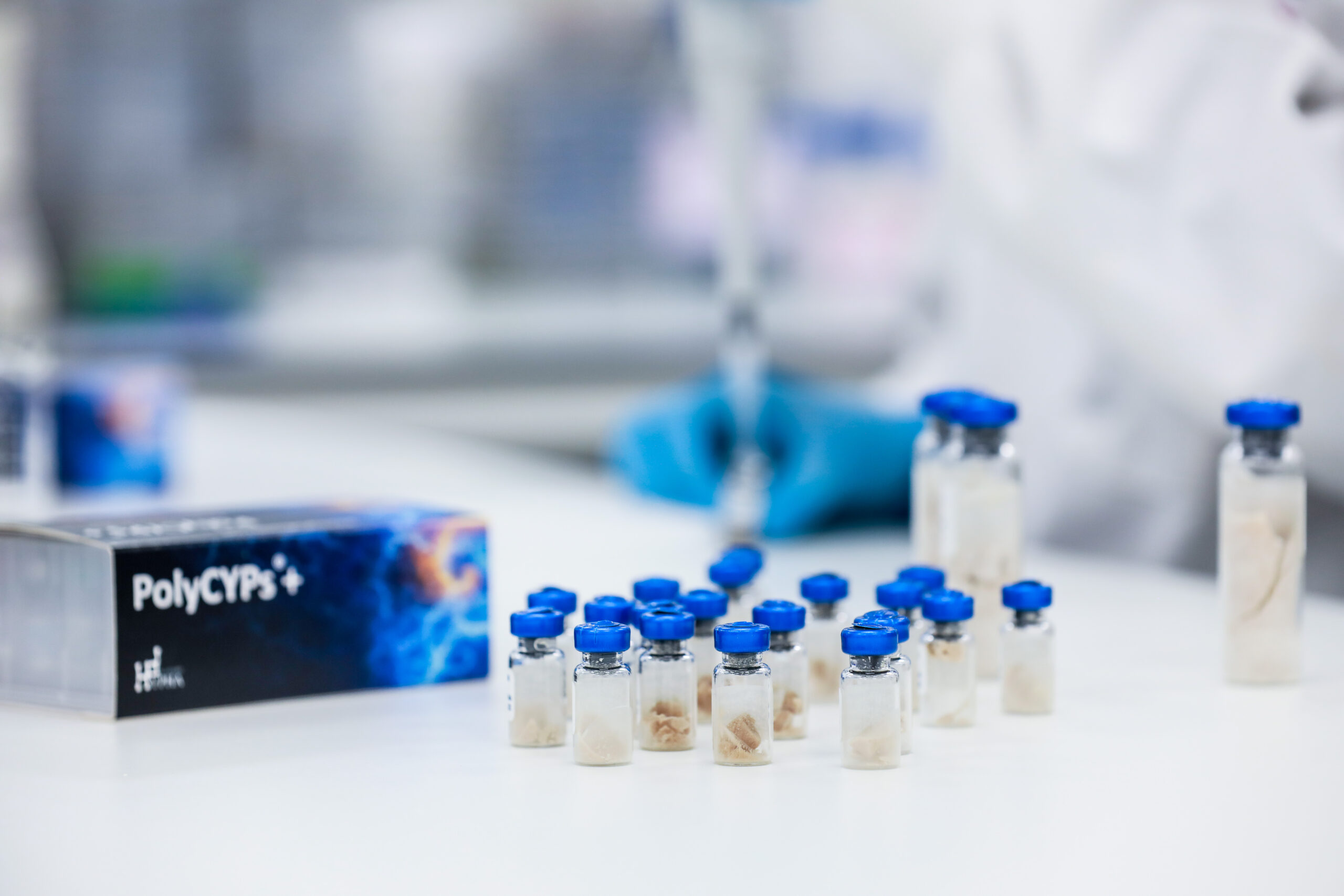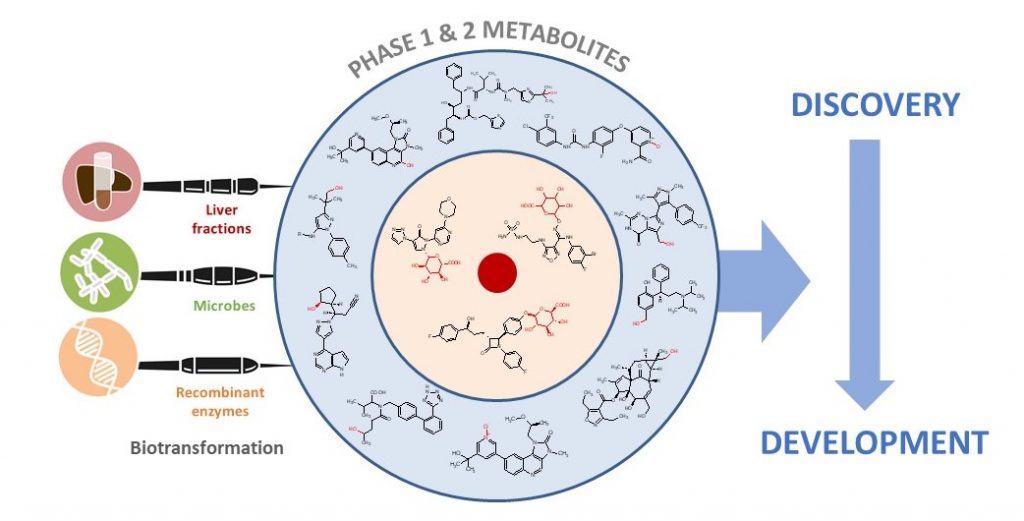Late Stage Functionalisation
PolarExplorer
Oxidised Derivatives using PolarExplorer
Hypha’s PolarExplorer late-stage functionalisation service delivers multiple oxidised derivatives of drugs and other small molecules through biocatalysis.
PolarExplorer uses PolyCYPs enzymes to provide a fast late-stage route to hydroxylate aliphatic or aromatic moieties at multiple sites in parallel, including metabolically susceptible positions. Both CYP-derived human metabolites and other oxidised derivatives can then be accessed simultaneously for structure elucidation and biological testing.
PolyCYPs® enzymes in the kit have been cloned from some of the talented actinomycete bacteria in Hypha’s biotransformation panel, providing a wide diversity of promiscuous CYPs that oxidise a variety of drug compounds.

The PolarExplorer process is straightforward and starts by screening a drug compound or other small molecule against a panel of different PolyCYPs isoforms, the reaction products of which are analysed by LC-MS to look for hydroxylated and other oxidised derivatives. PolyCYP isoforms able to produce derivatives of the compound can then be pinpointed, and a scale-up reaction performed to generate 1 mg+ amounts of derivatives at >90% purity by LC-ELSD for biological evaluation by the client. Structure elucidation can be performed by Hypha scientists by analysing data generated by a 700MHz 1.7mm cryoprobe NMR.
What We Do
Case Study
Generation of multiple hydroxylated derivatives of Alkermes’ lead compounds using PolarExplorer
A set of 7 lead compounds were screened blind against 12 PolyCYPs isoforms and the reaction products analysed by LC-MS to identify multiple oxidised derivatives, with 3 to 7 +16 Da products generated per compound. Derivatives of compounds 1 and 5 were prioritised for scale-up.
For compound 1, four +16 Da derivatives were observed in the initial screen and PolyCYP isoforms 359 and 484 were selected as the best to scale-up to capture these derivatives. Following purification of the scaled-up reaction, 5 different products were separated at a 33% isolated yield, ranging in weight from 2.46 mg to 28.05 mg. Alkermes opted to perform structure elucidation themselves on the purified derivatives provided by Hypha, revealing two derivatives with a secondary aliphatic hydroxylation, one derivative with a tertiary aliphatic hydroxylation, one derivative with aromatic hydroxylation and one rearranged structure from a tertiary aliphatic hydroxylation.
The work done to create oxidised derivatives using PolarExplorer allowed Alkermes to enhance their late-stage functionalisation efforts on compounds containing a complex molecular core and to rapidly expand their SAR understanding within projects.

Key features
Multiple oxidised derivatives produced in parallel
Process is compatible with screening client compounds stored in DMSO at concentrations typically used in client library inventory systems
Compounds can be screened blind - only need to know molecular weight
Lipophilic compounds are formulated to aid solubilisation
Scalable to produce mg to gram amounts of derivatives
Applicable to broad structural types and complex molecules, including natural products
Provides a solution for simultaneously accessing CYP metabolites
Significant overlap with mammalian metabolism translates into strong potential to detect active metabolites
Resources
Explore our library of resources comprising brochures, case studies, posters and publications about the work we do.
Introducing oxygen into a drug candidate late in the optimisation process has several applications including exploration of SAR (structure-activity relationships) and the ability to access derivatives that may possess superior properties such as improved metabolic stability and LLE (ligand-lipophilicity efficiency). Biocatalysis can provide access to chemical space in a complementary manner to chemical synthesis and provide a “one-experiment” solution to accessing multiple derivatives in parallel. This poster illustrates the application of a new biocatalysis kit, PolyCYPs®, to enable parallel synthesis of hydroxylated derivatives of drugs.
A cell-free kit of cytochrome P450 enzymes and ferredoxin/ferredoxin reductase redox partners, termed PolyCYPs®, is being developed for generating scalable quantities of oxidised metabolites. P450 cytochromes in the kit have been derived from some of Hypha’s most talented biotransforming bacteria and are capable of generating human and other mammalian metabolites of drug compounds.
In this paper, authors from Hypha and Incyte Corporation discuss the impact and application of biotransformation of drugs by mammalian systems, microorganisms, and recombinant enzymes, covering active and reactive metabolites, the impact of the gut microbiome on metabolism, and how insights gained from biotransformation studies can influence drug design.
Find out about our related services

The services conducted by Hypha allowed Alkermes to enhance our late stage functionalization efforts to rapidly expand our SAR understanding inside projects. In particular, the PolarExplorer work allowed facile generation of hydroxylated compounds possessing a complex molecular core. We look forward to engaging Hypha in the future because their team is professional, and their services complement our internal synthetic efforts for delivering new molecules.
Brian Aquila, Director of Medicinal Chemistry
Alkermes, MA, USA
Ready to begin? Our scientists are available to talk through your requirements
Hypha Discovery is a UK-based CRO supporting pharmaceutical and agrochemical companies worldwide through the production of metabolites and new derivatives of drugs and agrochemicals in discovery and development.
Resources
Cookie Policy | Privacy Policy | Website Terms and Conditions
© Hypha Discovery 2021. All Rights Reserved. Website by Fifteen.co.uk


